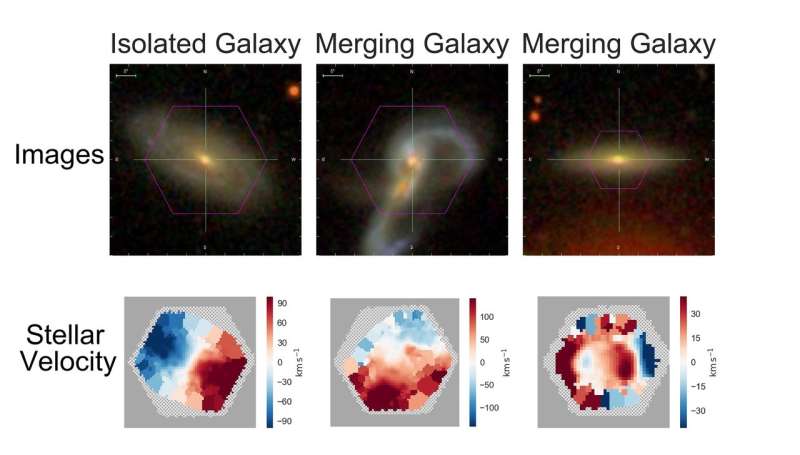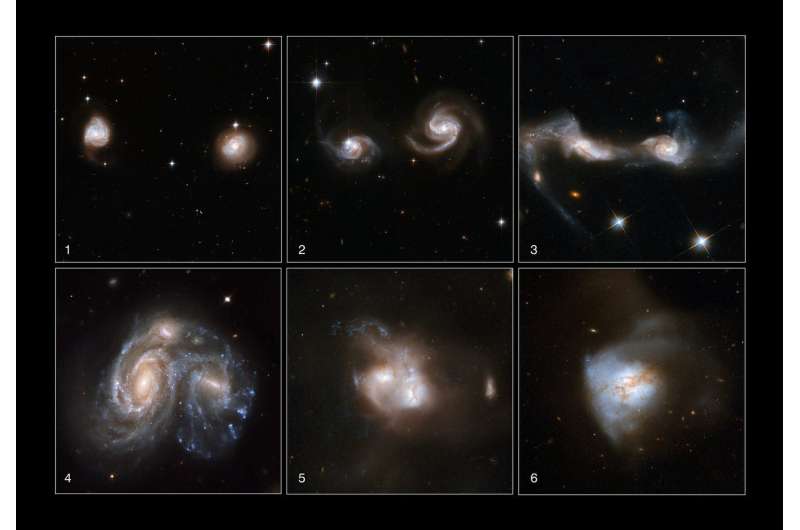Astronomers develop new tool to find merging galaxies

Today, at the 233rd AAS meeting in Seattle, astronomers from the Sloan Digital Sky Survey (SDSS) announce that they have developed a new tool to find otherwise-hidden galaxy mergers in data from the Mapping Nearby Galaxies at Apache Point Observatory (MaNGA) survey of SDSS. These results show that by going beyond simple searches for merging galaxies based just on how they look, astronomers will now be able find more galaxy mergers than ever before.
"Merging galaxies are key to understanding galaxy evolution, but finding them can be tricky," says Rebecca Nevin of the University of Colorado, the lead author of the study. Nevin is presenting this work this week as a Dissertation talk, as it formed the basis of her Ph.D. thesis at Colorado with Professor Julie Comerford.
A pair of merging galaxies is one of the most beautiful sights in astronomy, with giant tidal streams of stars and unusual shapes sometimes resembling animals (e.g. the Antennae, Mice, Tadpole, or Penguin galaxies). However, these beautiful visible features are visible are only found in a small fraction of merging galaxies – and even then only for a small part of the billions of years it takes for two galaxies to fully merge into one. Some galaxies that otherwise look "normal" may still be in the process of merging.
Astronomers have developed a way to find these hidden mergers. They created a method that uses simulations of merging galaxies to predict both how the mergers would look and how the stars in the galaxies would move. By comparing their results with observations of galaxies from the SDSS's Mapping Nearby Galaxies at Apache Point Observatory (MaNGA) survey, astronomers will be able to do much better at identifying merging galaxies in the wild.
"These simulations allow us to predict the more subtle signs of merging galaxies, so we can find mergers in SDSS data that were previously hidden," explains Laura Blecha (University of Florida), another key member of the team.
What the team is presenting today is the part of their method that analyzes galaxy images. They have essentially made a galactic photo album, including pictures of galaxies in all stages of merging. In the past, astronomers' "photo albums" of galaxy mergers were sparse, including only galaxies in the stage of merging where they looked like spectacular mergers.
"Nowadays, it would be totally unthinkable to take only one or two selfies every year," said Nevin. "We have modernized the galaxy merger photo album – now it's like taking one galaxy merger selfie a day for years."
The astronomers plan to make these extensive photo albums publicly available to everyone. Astronomers will use them to study how galaxies change as they undergo mergers.
The team's work so far is already a giant step forward in merger identification, but they are already taking the next step. They have already begun to incorporate data on how the stars move in the galaxies from the SDSS MaNGA survey. This will allow the team to identify even more mergers – those where the galaxy looks completely "normal."
The key to this new analysis is to incorporate data from MaNGA on how stars within galaxies are moving. "By going beyond images alone and incorporating stellar kinematics, we will find many more merging galaxies," says Karen Masters of Haverford College, the Spokesperson for SDSS. "We'll be able to learn how the merger process impacts how galaxies in our Universe evolve."

These stellar kinematics are revealed in the maps created by the SDSS's MaNGA survey. Because the spectra that MaNGA observes come from the light of all the stars in a particular part of a galaxy, stars, the spectra are slightly shifted by the Doppler Effect – blueshifted for the parts of a galaxy that are moving toward Earth and redshifted for the parts moving away from Earth. These subtle shifts reveal how the stars are moving around the galaxy.
When galaxies merge, the stars in them almost never collide, but they are thrown all around, creating dramatic distortions in the pattern of how stars move around the galaxy – patterns that astronomers refer to as "stellar kinematics." In a typical, non-merging spiral galaxy, the stars rotate in a simple, predictable pattern. But if such a galaxy is undergoing a merger, that simple pattern becomes chaotic, creating wild (but predictable) arrangements of stellar motion. When a galaxy's patterns of stellar motion have become distorted by a merger, the stellar kinematics data from MaNGA provides direct evidence of the merger. Nevin's team, which includes astronomers from the University of Colorado Boulder, the University of Florida, and Princeton University, is beginning to add stellar kinematics data into their work.
"As we improve our machine learning algorithms to incorporate the stellar kinematics of merging galaxies, we are able to identify different stages of the merger. The disturbances in the stars can last longer than imaging signatures of a merger like faint tidal tails, which fade much quicker. This means we can identify later stages in the merger, when in the imaging the galaxies look just like normal galaxies. This is a powerful new technique in the study of merging galaxies."
Understanding mergers is not only important to astronomers like Nevin's team; this understanding can help us predict the future of our own Galaxy. The Milky Way will merge with the Large and Small Magellanic Clouds in about 2.5 billion years – and is then predicted to merge with the much more massive Andromeda galaxy in five billion years, combining to form a single super-galaxy, which some dub "Milkdromeda." This event might throw the Sun out of the galaxy, but it won't matter to future inhabitants of Earth, which will have been swallowed by the Sun as it turns into a red giant star at around the same time. But maybe our descendants will see this for themselves as they travel among the stars.
Provided by Sloan Digital Sky Survey





















